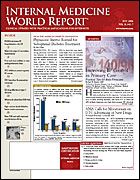Apply Adult CAP Guidelines to Geriatric Patients
From the American Thoracic Society
SAN DIEGO—Even though the risk of death from community-acquired pneumonia (CAP) is higher in elderly patients (those >65 years) than in younger adults, no guidelines have been developed exclusively for this patient population. New data demonstrate that following the general CAP guidelines can improve outcomes in the older age-group.
The results, which were released at the American Thoracic Society (ATS) 2006 International Conference, are drawn from the Community-Acquired Pneumonia Organization (CAPO) International Cohort study.
Forest Arnold, DO, Division of Infectious Diseases, University of Louisville, Kentucky, and colleagues investigated whether elderly patients with CAP have better outcomes if they are treated empirically according to the CAP guidelines issued in 2001 by the ATS.
These guidelines recommend initiating empiric antibiotic therapy with a regimen that covers typical and atypical pathogens. However, the guidelines were based on studies that did not include immunosuppressed patients or large numbers of special populations, such as the elderly.
J Respir Crit Care Med
The prevalence of CAP increases exponentially with age. In fact, one American study found that the incidence of CAP requiring hospitalization rose from 8.4 per 1000 people aged 65 to 69 years to 48.5 per 1000 people aged ≥90 years (. 2002; 165: 766-772). Because there are no CAP guidelines exclusively written for elderly patients, general adult CAP guidelines are used worldwide, according to Dr Arnold.
Using the CAPO database, initial empiric therapy for CAP was evaluated for compliance with ATS guidelines.
P
Among 1461 patients with CAP (aged ≥65 years), 986 patients were treated according to ATS guidelines, and 475 patients were not. The time to clinical stability was 3.33 days in both the compliant and noncompliant groups, and the length of hospitalization was 6.55 days in the guideline-compliant group and 6.98 days in the other group. Despite these similar outcomes, twice as many of those in the noncompliant group died compared with those who were treated according to the CAP guidelines (10.8% vs 5.7%; <.01).
Dr Arnold suggested that the improved outcomes when following the guidelines may be explained by the universal treatment of atypical pathogens, which are known to be responsible for up to 38% of CAP cases in hospitalized patients.
The results indicate that the ATS guidelines for CAP are applicable to the elderly and that undertreatment of CAP in this age-group is associated with worse outcomes.
Future studies should examine whether other aspects of the guidelines can be applied to the elderly, such as beginning antimicrobial therapy within 4 hours of diagnosis or practicing switch therapy (replacing intravenous antibiotics with effective oral antibiotics in the treatment of serious infections), Dr Arnold says.
KEY POINTS
The prevalence of CAP increases exponentially with age.
Undertreatment of CAP in the elderly results in excess mortality.
This study shows that using empiric antibiotic therapy for CAP in patients >65 years can save many lives.
